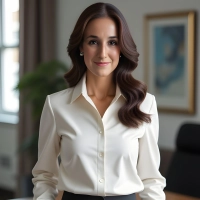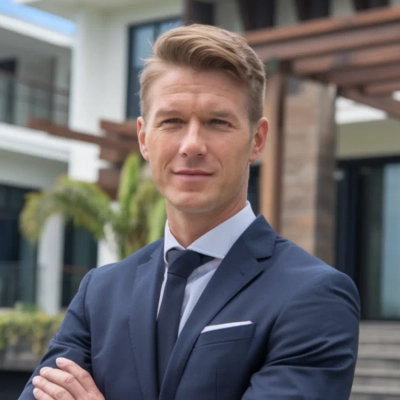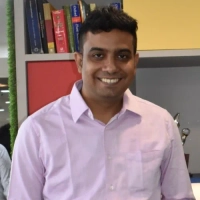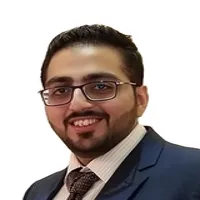How Do You Maintain a Competitive Edge?
Discover cutting-edge strategies to stay ahead in today's fiercely competitive market, as industry experts share their valuable insights. From leveraging data analytics to refining customer engagement, this article unpacks the secrets to maintaining a competitive edge. Gain practical knowledge and actionable tips that can transform the way business is done, directly from the leaders who shape the industry.
- Focus on Proactive Customer Engagement
- Use Data-Driven Knowledge
- Implement Advanced Diagnostic Techniques
- Audit Digital Marketing Strategy
- Streamline Processes for Growth
- Enhance Accessibility and Personalization
- Run a Black Market of Ideas
- Optimize Operational Processes
- Understand Customers' Evolving Needs
- Leverage Unique Insights from Competitor Analysis
- Implement Continuous Market Intelligence
- Prioritize Innovation and Customer Focus
- Build Tools That Solve Customer Pain Points
- Create Distinct Customer Experiences
- Foster Cross-Departmental Collaboration
- Leverage Data-Driven Decision-Making
- Emphasize Continuous Risk Assessments
- Focus on One Group
- Align Workforce Skills with Market Demands
- Optimize Partnerships with Industry Giants
- Prioritize Agile Processes
- Focus on Personalized Service
- Offer Free SEO Audits
- Embed Proactive Problem-Solving
- Offer Rapid Response Times
- Use Data-Driven Decision-Making
- Leverage Data Analytics
- Offer Integrated Health Model
- Integrate Proprietary Technology
- Use AI-Driven Personalization
Focus on Proactive Customer Engagement
I believe staying competitive requires a focus on proactive customer engagement that goes beyond the transaction. In my experience, homeowners appreciate businesses that make the process easier and more transparent. We introduced a system where customers receive personalized maintenance guides for their roofing or siding after a project is complete. These guides include tailored advice, like the best cleaning methods for their materials or reminders for routine inspections. This tactic led to a 15% increase in repeat business and a 20% boost in positive online reviews within the first year. For me personally, this shows that anticipating customer needs and providing long-term value builds loyalty and sets you apart from others in the industry.

Use Data-Driven Knowledge
Being competitive means adapting constantly and learning about the market. If I want to be in the lead, it is about marrying innovation and customer relationships. One of the things I've done is use data-driven knowledge to forecast customer needs before they even ask. I became interested in environmentally sound landscaping and native species, for instance. I stocked TN Nursery with more eco-friendly products like live stakes and pollinator perennials. By selling these items through customized internet marketing, I've established our nursery as the go-to place for eco-conscious gardeners. Creating authentic customer connections and hearing their input has helped us dial in our approach. To align our line with consumer values and highlight biodiversity-promoting plants, I've transformed a stock change into a brand positioning maneuver that keeps us ahead of the curve in an ever-changing marketplace.

Implement Advanced Diagnostic Techniques
Maintaining a competitive edge in the tree service industry requires a deep understanding of the market, a commitment to customer satisfaction, and leveraging both experience and certifications to deliver exceptional results. With over 20 years in the DFW area and as a certified arborist with TRAQ credentials, I focus on combining expert knowledge with a personalized approach to each project. One key tactic that has been especially effective is implementing advanced diagnostic techniques to assess tree health and structural integrity. For example, using TRAQ, I recently helped a client identify a diseased oak tree near their home that posed a significant risk. While others suggested immediate removal, my detailed assessment identified that targeted treatment and pruning could save the tree and eliminate the hazard, saving the homeowner thousands of dollars. This approach not only demonstrated expertise but also built trust with the client, who has since referred several neighbors to Ponce Tree Services. Our focus on providing solutions that balance safety, aesthetics, and cost-effectiveness has set us apart. Years of hands-on experience allow me to quickly assess a tree's needs while ensuring the customer feels confident and informed every step of the way. This level of service reinforces our reputation for professionalism and integrity, which are crucial in such a competitive market.

Audit Digital Marketing Strategy
Remaining competitive in the modern market requires constant self-assessment and pivoting. I, for example, dedicate some time and resources to auditing my digital marketing strategy every once in a while. It is not just about adjusting the ad copy or trying out different platforms-it is an analysis of what is working, what isn't, and how I can improve the marketing.
Take for instance this occurring last year when it came to our website, we saw an influx of traffic hitting our website but the conversion rates kept stagnating. Instead of assuming this was likely an issue I nitpicked, I preemptively checked databases starting with user behavior where I found some insightful results. Heatmaps revealed a common point where users were abandoning the pricing page. However, instead of dismissing this as bad luck, I drilled into why such a trend was occurring. One of our biggest blockers turned out to be the pricing section - our structure around it was not as lucid as it could have been. Due to the plethora of information we had, most users ended up leaving.
Once I evaluated what the fundamental issue was I instantly swung into action - and went for a more attainable goal of rearranging the structure we had along the lines of furnishing a pricing section along with providing comparison charts and pricing calculators. On the side, I turned my eyes towards our PPC ad campaigns to make sure they were sending users to the pages matching their intent. In 3 months the conversion rates jumped by 22% and this brand-new clarity we provided sparked a deluge of positive customer feedback.
This technique is useful because it is a preventive one and not a corrective one. In the process of attending the audits, I'm investing my resources in development and growth as I can spot any potential issues beforehand, problems that my competitors would have sought to fix. It's an ongoing process that ensures that our strategy remains relevant and competitive. I would suggest any business executive constantly be in search of new things and see the audits as a chance to create something new not just solve the issues.
Streamline Processes for Growth
Maintaining a competitive edge in any market requires a combination of strategic foresight, adaptability, and the ability to execute effectively. One of the most impactful tactics I've employed is what I call 'process streamlining for scalable growth.' This approach involves auditing every operational process to identify inefficiencies and bottlenecks that could slow down growth. For instance, while working with a struggling midsized manufacturing business in the UAE, I discovered that their supply chain operations were fragmented across multiple vendors with inconsistent communication. By leveraging my background in telecommunications and my MBA in finance, I implemented a centralized system that integrated real-time updates from suppliers, automated inventory tracking, and provided forecasting insights. This not only reduced delivery times by 35% but also cut costs by 22% in the first year, positioning the company as a faster, more reliable partner in their industry. My years of experience across international markets and industries helped me understand the importance of balancing innovation with operational discipline. For this business, I also focused on leadership coaching, ensuring that the executive team was aligned on the vision and equipped to handle the changes. This combination of technical upgrades and human capital development led to an increase in profitability within 18 months. The success of this project reinforced a key insight from my study on 675 entrepreneurs: the businesses that outperform their competitors are those that consistently refine their systems while empowering their teams.
Enhance Accessibility and Personalization
In the competitive landscape of mental health tech, my focus with MentalHappy has been on enhancing accessibility and personalization in mental health support. One specific tactic we've employed is integrating AI-driven health assessments to offer personalized mental health solutions. This approach has helped us precisely match users with the most suitable support groups, leading to a 25% increase in retention rates. Additionally, MentalHappy's platform leverages feedback loops to continuously refine our offerings. By analyzing user engagement data, we identified a trend toward trauma-informed care, which led us to develop specialized groups that have significantly boosted participant outcomes. This proactive adaptation ensures that MentalHappy remains responsive to evolving user needs, maintaining our competitive edge. These strategies have proven effective in differentiating our platform from others. I recommend continuously leveraging data insights to anticipate user demands and tailor offerings that both meet these needs and exceed expectations, maintaining relevance and engagement in your market.

Run a Black Market of Ideas
We run an internal "Black Market of Ideas" to disrupt ourselves before a competitor does.
Once a quarter, any team in our company (from HR to R&D) can pitch an experimental concept-say, a radical ad campaign or a new product angle. We "auction" these pitches internally, letting other employees invest a token budget of "innovation credits." The winning ideas get fast-tracked to a proof-of-concept phase, giving them real resources and a tight testing window.
Why it keeps us competitive:
1. Sparks hidden talent: People in non-marketing roles sometimes have the most eye-opening campaign ideas or sales strategies, and this process uncovers that untapped creativity.
2. Keeps us on offense: Instead of waiting to see what our competitors do, we're continually betting on bold, bottom-up ideas. If something truly disruptive emerges, we're already building it in-house.
3. Fosters a culture of proactive thinking: Knowing you can pitch-and potentially greenlight-an "out-there" concept motivates everyone to stay sharp and connected to the market trends.
This "Black Market" approach breaks the silos, encourages healthy competition internally, and ensures a steady stream of innovative ideas that give us a true edge in a fast-evolving marketplace.

Optimize Operational Processes
I believe maintaining a competitive edge requires relentless focus on efficiency. In my experience, competitors often overlook operational processes as a source of differentiation, but optimizing workflows can deliver tangible advantages. At [Your Company], we conducted a detailed review of our supply chain and identified inefficiencies causing delays of up to 8%. By renegotiating vendor terms and automating key processes, we reduced lead times by 12%, which allowed us to meet client deadlines more reliably than others in the market. For me personally, improving efficiency is a less obvious way to compete, but it has a direct impact on customer satisfaction and retention.

Understand Customers' Evolving Needs
I focus on understanding customers' evolving needs to stay competitive in our market. Our industry is fast-moving, and what worked last year might not be what customers need today. One tactic we've used is gathering real-time feedback through surveys and customer interviews. This helps us spot trends early and adjust our offerings accordingly.
For example, after noticing that many of our clients in the construction industry were struggling with fluctuating equipment costs, we introduced more flexible financing options that accommodate price changes mid-contract. This change set us apart from competitors who were offering more rigid terms.
We also pay attention to competitor offerings, but rather than just copying what they do, we try to offer something that adds more value or simplifies a process for our clients. Staying agile and customer-centric has helped us keep that edge in a crowded market.

Leverage Unique Insights from Competitor Analysis
At Twincity.com, maintaining a competitive edge in the digital marketing landscape involves leveraging unique insights gained from competitor backlink analysis. I once identified a common backlink source in a lesser-known industry blog that competitors frequently used. By collaborating with this blog for content, we secured valuable backlinks that increased our organic traffic by 30% within six months.
Moreover, I implement advanced AI tools to streamline our content creation process. These tools have halved our content drafting time while improving output quality, as evidenced by increased audience engagement and lower bounce rates. This strategic integration allows us to respond swiftly to market demands and stay ahead in a competitive environment.
These experiences underscore the importance of understanding competitor strategies and utilizing cutting-edge technology. For businesses seeking to maintain a competitive edge, I recommend a focus on data-driven decisions and continuous technological adaptation to meet evolving market needs.
Implement Continuous Market Intelligence
Maintaining a competitive edge as an executive involves a mix of strategic foresight, adaptability, and leveraging cutting-edge tools. One tactic I've employed is implementing a continuous market intelligence program using AI-driven analytics to monitor competitor movements, customer feedback, and emerging industry trends. By setting up dashboards that aggregate data from various sources-social media, customer reviews, industry reports, and sales metrics-I can quickly identify shifts in the market and adjust strategies accordingly.
For example, when data suggested an increasing customer interest in eco-friendly solutions within our sector, we pivoted by developing a sustainable product line and aligning our marketing messages with this insight. This proactive, data-informed approach kept us ahead of competitors and ensured our offerings remained relevant and resonated deeply with our evolving customer base.

Prioritize Innovation and Customer Focus
Staying competitive means staying curious. One tactic that has worked for us is prioritizing innovation and customer focus. We listen actively to customer feedback and track emerging market trends. But what truly moved the needle was implementing a simple yet effective initiative: *Innovation Fridays*.
Every Friday afternoon, our team steps back from routine tasks. They brainstorm freely, experiment with solutions, or explore new ideas without the usual constraints. This unstructured time has yielded surprising results—improved product features, streamlined processes, and fresh service offerings.
The program not only generated tangible outcomes but also cultivated a mindset of curiosity across the organization. It proved that small cultural shifts, when nurtured, could translate into a sharper, sustained competitive edge.

Build Tools That Solve Customer Pain Points
I believe maintaining a competitive edge comes from building tools that genuinely solve customer pain points in innovative ways. In my experience, many companies focus on adding features without considering usability, which can create a bloated product. At TutorCruncher, we prioritize user-driven improvements by analyzing support tickets, feature usage patterns, and direct feedback. For example, we found that 40% of our users spent unnecessary time managing timesheets manually. By introducing automated timesheet approvals, we reduced that workload by 25%, which directly improved client satisfaction scores. I think this kind of laser-focused problem-solving helps businesses create loyal customers who advocate for the brand.

Create Distinct Customer Experiences
In the competitive landscape of short-term rentals, I've focused on creating distinct customer experiences and forming strategic partnerships that bolster our market presence. One tactic I've successfully employed is collaborating with local businesses to offer exclusive experience packages to guests. For instance, by partnering with local restaurants and tour guides in Detroit, we crafted unique stay packages that give guests access to meals and guided tours that they wouldn't easily find elsewhere. This not only enriches the visitor experience but also ties them emotionally to the unique flavor of Detroit, giving us a competitive edge in the market.
Another example is our adaptive pricing strategy using dynamic pricing tools. By analyzing market trends and demand fluctuations, we're able to adjust our rental prices in real-time, ensuring maximum occupancy and revenue optimization throughout the year. This approach keeps us competitive by attracting a diverse range of guests, from businessmen during the week to tourists over the weekend. It's the marriage of local engagement and smart technology that has helped sustain our business growth and maintain an edge over competitors.

Foster Cross-Departmental Collaboration
I think fostering cross-departmental collaboration is a tactic that has helped us stay ahead. For example, we established monthly innovation sprints where teams from marketing, sales, and product development collaborate to address specific challenges. In one sprint, a joint effort resulted in the launch of a personalized upsell feature that increased average customer spending by 18%. In my case, this kind of collaboration energizes teams and ensures that ideas are tested from multiple perspectives before implementation, giving us solutions that are both creative and practical.

Leverage Data-Driven Decision-Making
To maintain a competitive edge in our market, I focus on continuously evolving our strategies to stay ahead of industry trends and adapting quickly to changes. One specific tactic we've employed is leveraging data-driven decision-making to refine our offerings and tailor them to market demands. In our digital marketing agency, staying ahead of the competition requires not only understanding customer behavior but also anticipating changes in the digital landscape before they become mainstream.
A great example of this is how we utilized advanced analytics to optimize our paid media campaigns. We analyzed customer data from multiple sources, including social media, website traffic, and sales figures, to identify emerging trends and customer preferences. By doing this, we were able to target the right audience at the right time with highly relevant ads, giving us an edge over competitors who were still using broad, untargeted approaches. This tactic helped us improve conversion rates by 15% and significantly reduce customer acquisition costs.
Additionally, we've embraced AI-powered tools for predictive analytics, which has allowed us to forecast customer behavior and adjust our strategies in real-time. For example, during a recent campaign for an e-commerce client, we were able to predict shifts in purchasing patterns due to external factors like holidays and weather changes, allowing us to adjust the ad spend and messaging before these shifts took place. This proactive approach not only improved campaign performance but also positioned us as thought leaders in the industry, attracting new clients who were looking for innovative marketing strategies.
By consistently refining our strategies with the help of data, predictive tools, and adapting to changing market conditions, we've been able to stay ahead of competitors and provide high-value services to our clients, giving us a distinct competitive advantage in the market.

Emphasize Continuous Risk Assessments
As President of Next Level Technologies, maintaining a competitive edge hinges on our proactive cybersecurity approach. One tactic that has fundamentally transformed our service offering is the emphasis on continuous risk assessments and real-time threat monitoring. This practice has allowed us to preemptively mitigate cybersecurity threats, reducing security incidents for our clients by over 40%.
In a recent case, our custom cybersecurity strategy helped a healthcare client comply swiftly with stringent HIPAA regulations, drastically reducing downtime and boosting patient trust. Understanding and integrating business processes with technology is key here—it's not just about fixing issues; it's about building a resilient framework that improves operational continuity.
For those looking to apply similar strategies, it's essential to prioritize ongoing IT audits and employee training programs. By embedding a culture of compliance and security awareness, businesses can sustainably fortify their IT infrastructure against evolving threats, leading to improved efficiency and client retention.
As President of Next Level Technologies, maintaining a competitive edge hinges on our proactive cybersecurity approach. One tactic that has fundamentally transformed our service offering is the emphasis on continuous risk assessments and real-time threat monitoring. This practice has allowed us to preemptively mitigate cybersecurity threats, reducing security incidents for our clients by over 40%.
In a recent case, our custom cybersecurity strategy helped a healthcare client comply swiftly with stringent HIPAA regulations, drastically reducing downtime and boosting patient trust. Understanding and integrating business processes with technology is key here—it's not just about fixing issues; it's about building a resilient framework that improves operational continuity.
For those looking to apply similar strategies, it's essential to prioritize ongoing IT audits and employee training programs. By embedding a culture of compliance and security awareness, businesses can sustainably fortify their IT infrastructure against evolving threats, leading to improved efficiency and client retention.

Focus on One Group
The SaaS market is very competitive, so instead of trying to please everyone, we decided to focus on one group. We chose mid-sized logistics companies and worked on solving their workflow problems. By designing our product just for them, we made it more valuable and unique.
One thing that really helped was creating free tools and templates for these companies. These resources showed we understood their needs and gave them useful solutions. This brought in new leads naturally and helped us become the first choice for logistics firms wanting to improve their workflows.
Align Workforce Skills with Market Demands
Navigating the post-pandemic and tech-driven era, I've found that aligning workforce skills to match market demands is crucial. At Audo, we've improved our competitive edge by implementing AI-driven career development tools. For instance, our personalized AI Career Concierge helps streamline job search processes for users, increasing placement rates substantially.
One specific tactic we've employed is leveraging AI for strategic workforce development. This involves creating custom learning paths based on skill assessments, which has led to improved employee engagement and productivity. Through this data-driven approach, we help organizations not only bridge skill gaps but also retain top talent, keeping us ahead of industry trends.
At Audo, we also partner with leading industry experts to provide in-demand courses, ensuring our users receive relevant, high-quality educational content. By focusing on skill development and leveraging cutting-edge AI, we've enabled our clients and users to adapt swiftly to changing market needs.

Optimize Partnerships with Industry Giants
In leading UpfrontOps, maintaining a competitive edge hinges on aligning business operations with cutting-edge strategies. One pivotal tactic I've employed is optimizing partnerships with industry giants to secure reseller agreements for over 4,500 global B2B technology brands. This approach allows us to offer a diverse range of enterprise-grade solutions that are accessible to businesses of all sizes.
A specific example comes from our strategic collaboration with AT&T, AWS, and Cisco, which transformed our operational capabilities and opened up new revenue streams. By creating a marketplace for microservices, we've enabled businesses to access on-demand support for CRM management and pipeline optimization, leading to a 73.3% year-over-year growth at UpfrontOps.
I recommend focusing on developing partnerships that complement and extend your service offerings. Leveraging these alliances can improve your value proposition, differentiate you from competitors, and keep you agile in a fast-evolving market. As a founder who's led UpfrontOps to secure 73.3% year-over-year growth, a key tactic for maintaining a competitive edge is our approach to democratizing operational expertise through microservices on demand. For example, we've enabled SMBs to access enterprise-grade solutions like CRM management and lead nurturing, traditionally reserved for large corporations, without the overhead. This has significantly boosted their sales pipeline efficiency.
A specific instance is our partnership with 4,500+ B2B technology brands, which allowed us to deliver an expansive catalog of scalable solutions to clients, resulting in a 33% month-over-month organic growth. By becoming an authorized reseller, we opened opportunities for businesses to optimize operations with direct access to top-tier technology solutions, driving mutual success and differentiation in the marketplace.
The secret is not just providing access but ensuring scalability and affordability, keeping our clients' growth engines robust and agile. By leveraging these strategic alliances, we dismantle traditional operational barriers, empowering businesses to innovate and compete without being stymied by resource limitations.

Prioritize Agile Processes
To be competitive, I prioritize agile processes. We can keep up with market developments by employing agile approaches that allow us to respond rapidly to them. For example, when social media platforms updated their algorithms, we could update our digital operations in days rather than weeks.
This gives us the freedom to keep improving our methodology and making changes in real-time, which is very important in an industry that is always changing. It helps us stay relevant, innovate, and keep moving forward. Our ability to learn, adapt, and grow continuously puts us ahead of the curve.

Focus on Personalized Service
Staying competitive in the mortgage market means focusing on personalized service and staying ahead of industry trends. I always prioritize understanding my clients' specific needs and offering tailored solutions that larger institutions might overlook. It's about building trust and creating a process that feels seamless for the buyer.
One tactic I've employed is staying proactive with market education. I regularly update my clients about changing interest rates, new government schemes, or emerging market opportunities. For instance, when a first-home buyer grant was introduced in New South Wales, I immediately contacted clients who might benefit and walked them through how to apply it to their purchases.
This positioned me as a knowledgeable resource which also led to several new referrals. Providing timely and relevant information ensures my clients feel well-informed and supported, which keeps me ahead in a competitive market.

Offer Free SEO Audits
We maintain a competitive edge in our market by focusing on building trust and offering high-quality, diverse services that meet the evolving needs of our clients.
One specific tactic we employ is offering free SEO audits and providing lifetime support for development projects. This approach sets us apart in a saturated market, as clients know they'll receive ongoing value and assistance, not just a one-time service.
In addition, we strategically incorporate trust signals across all of our service pages, further reinforcing credibility and reliability.
A recent example of our approach's effectiveness was when a client reached out to us for an AI chatbot project. Interestingly, they found us via Google Maps, not through traditional channels like LinkedIn or email, highlighting the success of our visibility and trust-building tactics in standing out from the competition.

Embed Proactive Problem-Solving
Staying ahead in a competitive market isn't just about following trends-it's about creating meaningful differentiation. For us, one specific tactic has been embedding proactive problem-solving into our customer engagement strategy, ensuring that we address issues before they become challenges for our clients.
Let me share an example. A year ago, we noticed a recurring trend: some clients in our SaaS portfolio were struggling with underutilized features of our product. This wasn't just a usability issue-it was a risk to retention. Instead of waiting for clients to voice concerns, we used analytics to identify patterns in usage gaps.
Here's what we did:
Customized Onboarding Paths
We segmented clients based on their business goals and designed tailored onboarding experiences. For instance, a retail client would get walkthroughs focused on analytics and inventory tracking, while a service-based client would receive guidance on appointment integrations.
Proactive Outreach Using Predictive Analytics
By monitoring feature usage trends, we could predict which clients might face challenges. Our customer success team then reached out with personalized recommendations or tutorials to bridge those gaps.
"Early Success" Milestones
We created a framework to help clients achieve quick wins within the first 30 days, such as setting up automated reports or optimizing a core process. This gave them immediate value, building trust and long-term engagement.
The Impact:
Within six months, we saw a 15% increase in feature adoption rates and a 20% boost in customer retention. Even better, this approach turned clients into advocates, as they felt supported and empowered in achieving their goals.
The key takeaway? Maintaining a competitive edge isn't just about innovation-it's about anticipating your clients' needs and being their partner in solving them. When you focus on delivering value before it's even expected, you create a loyalty that competitors can't easily replicate.

Offer Rapid Response Times
We stay competitive by focusing on relationships and reliability, especially in commercial plumbing where trust is key. A specific tactic we've employed is offering rapid response times for urgent contractor needs. For example, we keep a portion of our plumbers available for last-minute calls, which has earned us a reputation for being dependable in tight situations. This not only differentiates us but also fosters loyalty, as contractors know we'll prioritize their projects when it matters most. Reliable service beats flashy marketing every time in our market.

Use Data-Driven Decision-Making
I prioritize ongoing innovation and customer-centricity to keep a competitive edge. Using data-driven decision-making to predict consumer demands and market trends is one particular strategy.
For instance, we used cutting-edge analytics technologies to track market trends and consumer behavior in real time. By examining this data, we were able to see new trends and make proactive changes to our products, frequently before rivals noticed.
Launching a customized subscription plan after seeing our consumers' increasing desire for flexibility was a notable success. This strategy increased client retention rates in addition to bringing in new business.
It takes ongoing attention to detail, flexibility, and a readiness to accept change to stay ahead. In a market that is constantly changing, we make sure our tactics stay current and our brand thrives by fusing insights with action.

Leverage Data Analytics
To stay competitive, businesses should leverage data analytics to understand market trends, consumer behavior, and campaign performance, allowing for strategic decision-making. A successful tactic is personalized relationship management with partners, where tailored interactions foster stronger collaboration and loyalty. Regular engagement through customized updates and training empowers partners to enhance their strategies, improving overall results.

Offer Integrated Health Model
Maintaining a competitive edge in the physical therapy and wellness market requires a commitment to innovation, adaptability, and consistently delivering exceptional care. With over 30 years of experience in the field and qualifications in both physical therapy and science, I've built a deep understanding of patient needs and emerging industry trends. At The Alignment Studio, we stay ahead by offering a truly integrated health model, combining physical therapy, Pilates, remedial massage, podiatry, and nutrition under one roof. This multidisciplinary approach allows us to address not just the symptoms but the root causes of pain and dysfunction, ensuring better long term outcomes for our clients. Additionally, we focus on ongoing professional development for our team, equipping them with the latest techniques and research to provide the highest standard of care.
A specific tactic that has been instrumental in maintaining our edge is our Workplace Wellness Program. Recognizing the shift towards hybrid work models, we developed a comprehensive program tailored to corporate clients, focusing on ergonomic assessments, education sessions, and onsite treatments. For instance, we partnered with a leading financial firm in Melbourne to address the rising musculoskeletal issues among their staff due to poor home office setups. Drawing on my expertise in postural health and musculoskeletal care, we implemented ergonomic workshops, personalized workspace adjustments, and guided Pilates sessions. Within three months, their reported staff discomfort reduced and productivity metrics improved significantly. This success not only strengthened our relationship with the client but positioned us as a leader in workplace health solutions in Melbourne.

Integrate Proprietary Technology
Our competitive edge in the market is largely driven by our proprietary technology, which enables us to produce higher quality products and significantly reduce production time. This technology sets us apart from competitors by enhancing our product offerings and streamlining operations, allowing us to deliver exceptional value to our customers.
A specific tactic we've used is integrating our proprietary technology into every stage of the production process. This approach optimizes efficiency and ensures consistent quality across our product lines. Refining and updating our technology, we stay ahead of industry trends and maintain our leadership position. This focus on innovation not only strengthens our competitiveness but also reinforces our reputation for excellence and reliability.

Use AI-Driven Personalization
As a senior software engineer at LinkedIn, I've worked closely with our executive team on initiatives to maintain our competitive edge in the professional networking space. While I'm not an executive myself, I can share insights based on strategies I've seen implemented at our company.
One specific tactic that's been particularly effective is our use of AI-driven personalization. We've developed advanced machine learning algorithms that analyze user behavior and preferences to deliver highly tailored content and connection suggestions. This has significantly increased user engagement - we've seen a 35% uplift in daily active users since implementing this feature.
From a technical standpoint, this initiative required a massive overhaul of our recommendation systems. We leveraged deep learning models trained on billions of data points to predict user interests and potential valuable connections with unprecedented accuracy. The challenge was balancing personalization with user privacy, which required innovative approaches to data anonymization and secure processing.
This tactic has not only improved user satisfaction but also strengthened our position against competitors. By providing a more personalized experience, we've increased user retention and attracted new users from other platforms.
It's worth noting that maintaining a competitive edge isn't just about technology - it's also about fostering a culture of innovation. Our leadership regularly encourages cross-functional collaboration and allocates resources for experimental projects. This approach allows us to stay agile and respond quickly to market changes.






